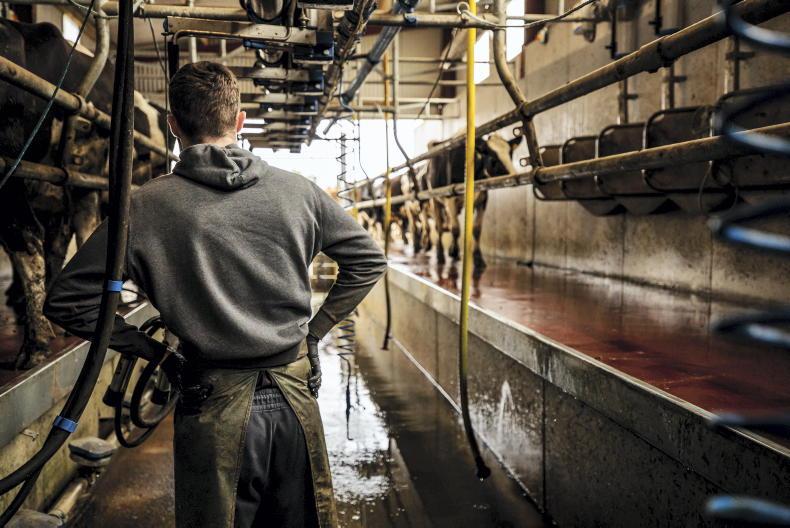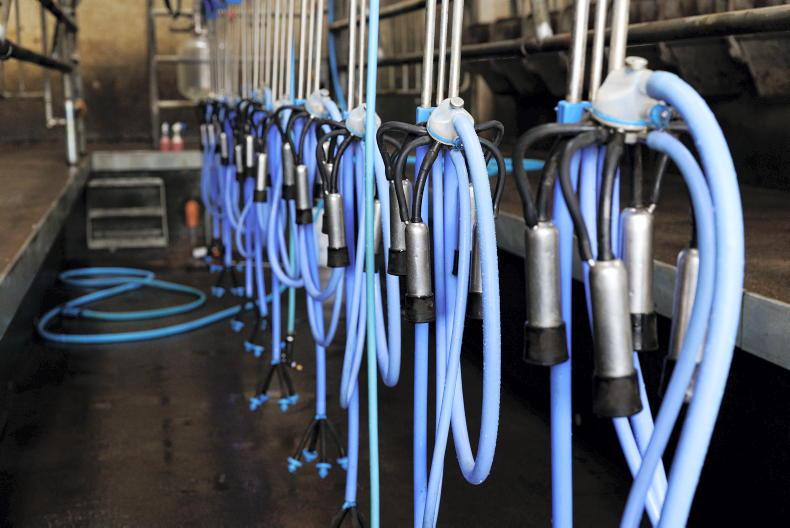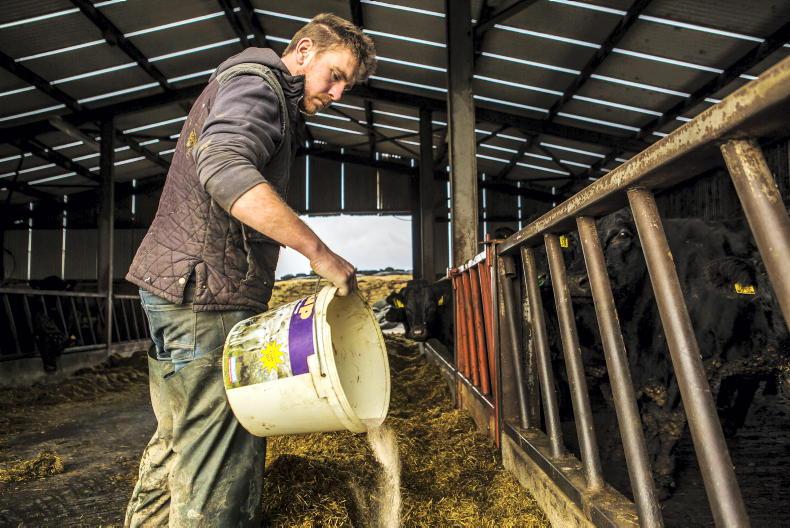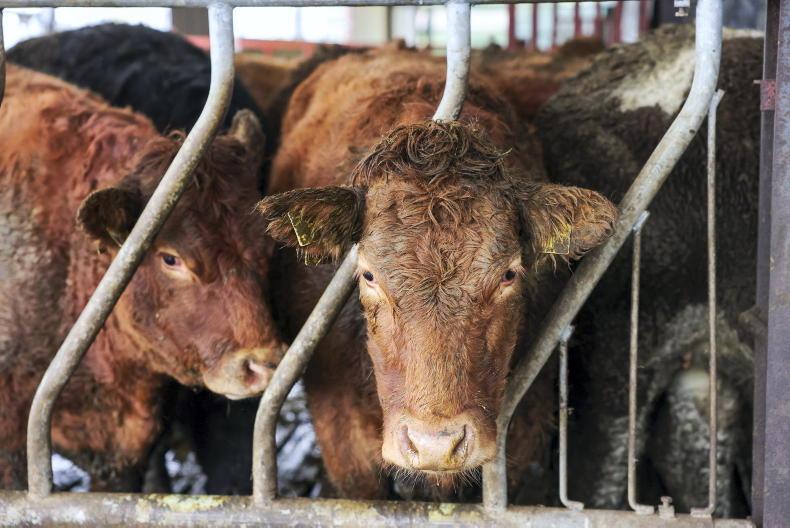Introducing robots has allowed for more time to focus on the grazing system and has improved herd health without the need for additional labour, according to Cork farmer Martin Kelly.
Martin farms in partnership with his wife Derval and parents Donal and Gretta at Monaclarig Farm, Kinsale in Cork. The farm’s 180 milkers were moved to three DeLaval VMS robots in August 2024 having been previously milked in a 16-unit herringbone parlour.

Three DeLaval robots have been installed, replacing an older 16 unit parlour.
“We updated the parlour to include cluster flush and feed-to-yield technology during the 15 years we have had it. We also brought in collars for the herd to provide more data on cow health. We could milk the herd in around two hours but had problems finding reliable labour which meant too much of my time was spent in the parlour,” says Martin.
The farm stretches to over 330 acres, giving the Kelly’s plenty of grazing land for the milkers, 40 followers and beef stock. The robots have been incorporated into existing buildings which has reduced the overall cost of the switch and will also create more space when the old parlour is sold.
“I looked at a rotary parlour, but there would have been too much investment in new buildings.
The robots have been positioned neatly in our existing housing and we have incorporated the gates that enable an A, B, C grazing system so the cows have free movement to graze and come in to be milked in their own time,” he says.
The A, B, C grazing system uses permission gates to move cows from the robots to grazing areas that are adjusted on a daily basis. Strip wires are used to divide paddocks and a series of cow roadways enables the herd to move to fresh pasture throughout the day.
Time saver
“It takes a fraction of the time to adjust some fences to what I was spending milking in the parlour. I used to have to milk at 6am. Now I can set the fences, and I still have time to take the children to school,” he says.

Martin has plenty of help around the farm and has found extra time for family since he installed robots.
Labour concerns and five children led the family to consider robotic milking. However, beyond the practical time benefits, Martin has also seen improvements to cow health.
“Bringing cows in twice a day, at the same time, meant more standing and more stress. The cows are now able to come in when they want to be milked and that has improved foot health and reduced stress,” he explains.
The farm has the benefit of free-draining land that provides good grass growth for a longer than average period.
This, and seeing the cows out in the field were motivating factors that have helped to keep overheads low and cow welfare high.
“We can have the cows out as early as January, and some years we have managed a full rotation by St Patrick’s Day. We have retained the feed to yield with the robots and the cows have adjusted wwell to the way the A, B, C system works,” he says.
The farm’s previous grazing pattern was not dissimilar to the A, B, C system. However, some adjustments have been made to reduce some paddocks, with the largest at around five acres.

Cows come in and out for milking voluntarily on the Kelly farm.
The difference he says is that by creating smaller grazing areas and allowing the cows free movement, damage at gaps has reduced where cows used to wait to be collected for milking. This has improved grass quality too, he says.
“We chose to position the robots in front of the old parlour so cows that wanted to be milked had to go through the gates, and the robots, to get where they wanted to go. After just three months the herd has settled well and cow flow is where it needs to be,” he says.
There are fewer cases of lameness in the herd now that cows are milking individually, and Martin suggests that by not pushing the cows in to be milked as a herd, the rush and stress has been removed.
“I carry out all the hoof care myself and have seen improvements across the herd. We have historically had higher than average SCCs at around 190,000 and, in the spring, before the robots were installed, we had rising mastitis cases.
The robots four quarter milking system has had an immediate impact on this, and mastitis cases have dropped significantly,” he says.
Udder health
The DeLaval VMS robots operate four quarter milking which enables the vacuum level to adjust to each teat. This has been seen to improve udder health in other robotically milked herds and Martin is hoping that this, and more data about each cow, will help him to spot any issues faster.
The herd is calved in autumn and spring, and the herd saw an initial drop in yield when the robots were installed in August as the spring-calved cows settled in. However, the autumn calvers have already reacted well and Martin suggests that milk yields are on the rise.
“The autumn calvers are flying and we expect this to push yields up as we move through our first year. It will take a year for the system to bed in, but, in the meantime, I am also finding ways to cut costs in other areas of the farm,” he adds.
Farm Facts
Monaclarig Farm
330 acres. 180 in milk. Autumn and spring calving. 40 followers.7,000 litres per cow per year.4.18% butterfat. 3.57% protein.
Introducing robots has allowed for more time to focus on the grazing system and has improved herd health without the need for additional labour, according to Cork farmer Martin Kelly.
Martin farms in partnership with his wife Derval and parents Donal and Gretta at Monaclarig Farm, Kinsale in Cork. The farm’s 180 milkers were moved to three DeLaval VMS robots in August 2024 having been previously milked in a 16-unit herringbone parlour.

Three DeLaval robots have been installed, replacing an older 16 unit parlour.
“We updated the parlour to include cluster flush and feed-to-yield technology during the 15 years we have had it. We also brought in collars for the herd to provide more data on cow health. We could milk the herd in around two hours but had problems finding reliable labour which meant too much of my time was spent in the parlour,” says Martin.
The farm stretches to over 330 acres, giving the Kelly’s plenty of grazing land for the milkers, 40 followers and beef stock. The robots have been incorporated into existing buildings which has reduced the overall cost of the switch and will also create more space when the old parlour is sold.
“I looked at a rotary parlour, but there would have been too much investment in new buildings.
The robots have been positioned neatly in our existing housing and we have incorporated the gates that enable an A, B, C grazing system so the cows have free movement to graze and come in to be milked in their own time,” he says.
The A, B, C grazing system uses permission gates to move cows from the robots to grazing areas that are adjusted on a daily basis. Strip wires are used to divide paddocks and a series of cow roadways enables the herd to move to fresh pasture throughout the day.
Time saver
“It takes a fraction of the time to adjust some fences to what I was spending milking in the parlour. I used to have to milk at 6am. Now I can set the fences, and I still have time to take the children to school,” he says.

Martin has plenty of help around the farm and has found extra time for family since he installed robots.
Labour concerns and five children led the family to consider robotic milking. However, beyond the practical time benefits, Martin has also seen improvements to cow health.
“Bringing cows in twice a day, at the same time, meant more standing and more stress. The cows are now able to come in when they want to be milked and that has improved foot health and reduced stress,” he explains.
The farm has the benefit of free-draining land that provides good grass growth for a longer than average period.
This, and seeing the cows out in the field were motivating factors that have helped to keep overheads low and cow welfare high.
“We can have the cows out as early as January, and some years we have managed a full rotation by St Patrick’s Day. We have retained the feed to yield with the robots and the cows have adjusted wwell to the way the A, B, C system works,” he says.
The farm’s previous grazing pattern was not dissimilar to the A, B, C system. However, some adjustments have been made to reduce some paddocks, with the largest at around five acres.

Cows come in and out for milking voluntarily on the Kelly farm.
The difference he says is that by creating smaller grazing areas and allowing the cows free movement, damage at gaps has reduced where cows used to wait to be collected for milking. This has improved grass quality too, he says.
“We chose to position the robots in front of the old parlour so cows that wanted to be milked had to go through the gates, and the robots, to get where they wanted to go. After just three months the herd has settled well and cow flow is where it needs to be,” he says.
There are fewer cases of lameness in the herd now that cows are milking individually, and Martin suggests that by not pushing the cows in to be milked as a herd, the rush and stress has been removed.
“I carry out all the hoof care myself and have seen improvements across the herd. We have historically had higher than average SCCs at around 190,000 and, in the spring, before the robots were installed, we had rising mastitis cases.
The robots four quarter milking system has had an immediate impact on this, and mastitis cases have dropped significantly,” he says.
Udder health
The DeLaval VMS robots operate four quarter milking which enables the vacuum level to adjust to each teat. This has been seen to improve udder health in other robotically milked herds and Martin is hoping that this, and more data about each cow, will help him to spot any issues faster.
The herd is calved in autumn and spring, and the herd saw an initial drop in yield when the robots were installed in August as the spring-calved cows settled in. However, the autumn calvers have already reacted well and Martin suggests that milk yields are on the rise.
“The autumn calvers are flying and we expect this to push yields up as we move through our first year. It will take a year for the system to bed in, but, in the meantime, I am also finding ways to cut costs in other areas of the farm,” he adds.
Farm Facts
Monaclarig Farm
330 acres. 180 in milk. Autumn and spring calving. 40 followers.7,000 litres per cow per year.4.18% butterfat. 3.57% protein. 











SHARING OPTIONS